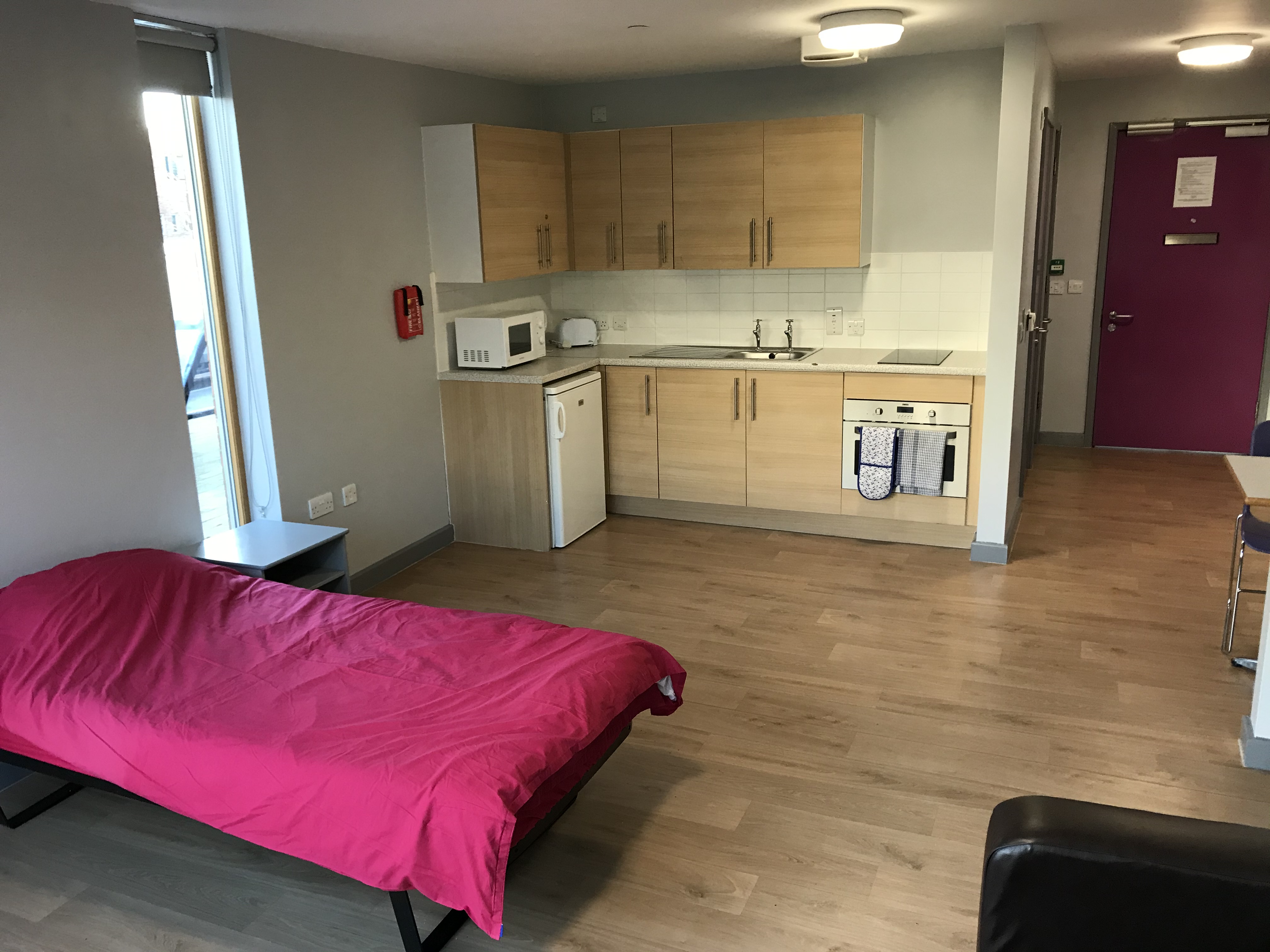 Good quality accommodation - Statutory Temporary Accommodation (Cherry Tree View) - A resident and child enjoying the playground - © World Habitat
Good quality accommodation - Statutory Temporary Accommodation (Cherry Tree View) - A resident and child enjoying the playground - © World Habitat Good quality accommodation - Statutory Temporary Accommodation (Cherry Tree View) - living space in a self contained apartment for a single person - © World Habitat
Good quality accommodation - Statutory Temporary Accommodation (Cherry Tree View) - living space in a self contained apartment for a single person - © World Habitat
City
Newcastle upon Tyne
Main actors
City Government, NGO / Philanthropy, Community / Citizen Group
Project area
Whole City/Administrative Region
Duration
Ongoing since 2013
A unique partnership prevents thousands of citizens becoming homeless.
Homelessness prevention in Newcastle upon Tyne is a citywide approach that identifies and supports people at risk of homelessness - before they reach crisis point, rather than responding afterwards.
In response to severe budget cuts and their likely impact on the most vulnerable households, Newcastle City Council developed its Active Inclusion Newcastle partnership approach to support residents to have a stable life – somewhere to live, an income, financial inclusion and employment opportunities.
In a city facing reducing incomes and increasing poverty, this approach has maintained extremely low and stable levels of homelessness in spite of a challenging background nationally, preventing thousands of households from becoming homeless.
World Habitat Awards
This project was awarded the 'World Habitat Awards' in 2020 in the following category: Gold.
Newcastle upon Tyne, in the north-east of England, has long-standing issues of poverty and deprivation. Almost one in four (24%) of Newcastle’s population lives in areas that are among the most deprived in the UK, while one-in-five (20%) of households have no adult in employment. Child poverty is also significantly higher than the national average – almost one-in-three (29.1%) of children live in low-income families.
The programme of austerity, implemented by the UK Government from 2010, cut the City Council’s budget by 32% - making Newcastle one of the worst-affected local authorities in England. Newcastle has also been among the worst impacted by national government welfare reductions – an estimated US $150 million will have been cut from 40,000 of the lowest-income working-age residents by 2024. An estimated 38,000 households access foodbanks.
The austerity cuts from 2010 onwards reduced funding to respond to homelessness at a time when residents faced increased hardship. However, rather than focus solely on frontline services that help people after they become homeless, the council maintained its preventative approach to homelessness.
Newcastle City Council developed its first statutory homelessness strategy in 2003, making homelessness prevention its key aim. The main purpose of Newcastle’s approach is to prevent homelessness at the earliest opportunity by supporting residents at risk of homelessness due to debt, income and housing inequality to develop and maintain the foundations for a stable life.
Homelessness prevention fits within the Active Inclusion Newcastle (AIN) partnership approach, which was developed in 2013. It was created to address:
- the growth in demand for homelessness prevention and financial inclusion information, advice and support at a time of reduced resources;
- the scale of poverty and disadvantage many Newcastle residents face; and
- the need to change culture to promote preventative and partnership responses.
The AIN partnership focuses on supporting residents to have the foundations for stability, expressed simply through the acronym ‘LIFE’: L: Somewhere to Live; I: an Income; F: Financial inclusion; and E: Employment opportunities.
The City of Newcastle’s approach focuses on low-income, excluded and vulnerable residents who may in the future be at risk of losing their home.
The foundation of the approach is the retention of a large stock of council housing (26,000 homes), managed by its arm’s-length management organisation (ALMO), Your Homes Newcastle, and commissioned supported accommodation (779 individual rooms).
The homelessness prevention work has three components.
Primary prevention activities focus on ‘adapting’ core services for vulnerable residents. This has been achieved through a programme of system-change which has included non-housing related multi-agency staff trained to identify and respond to at-risk residents with whom they come into contact.
Secondary prevention activities take the form of ‘targeted’ specialist advice and support, including specialist information, advice and accommodation services on key issues such as housing, debt and welfare.
The third and final strand of the work concerns crisis activities. The aim here is to ‘catch’ residents experiencing crisis, providing emergency accommodation for people who have not been identified earlier and have been evicted or had a relationship breakdown, for example.
In 2019/20, 30,601 residents were advised by AIN partners. This included supporting 23,198 residents to secure around US $37 million in welfare benefits, providing 3,853 residents with debt advice, and preventing 3,745 households from becoming homeless.
Residents at potential risk of homelessness are also proactively identified through various routes, including those affected by the removal of the spare room subsidy or ‘bedroom tax’, those affected by the benefit cap, and households requesting emergency support (such as food) including during the COVID-19 pandemic.
The approach to supporting residents is designed to be as individual as possible. For some, access to universal information through the website is sufficient, while others require targeted welfare rights or debt advice. For residents in more complex situations, more integrated responses to improve engagement and support are developed. This approach also allows the identification of residents who do not require support, after further screening of their circumstances.
This approach is supported by a single database – the Newcastle Gateway – for homelessness and housing-related support services in the city, which has helped staff to link over 23,000 residents with 72 services. This provides an evidence-base of the extent and nature of homelessness locally. This data is used to support quarterly review processes – including internal meetings with management and frontline practitioners working in homelessness services.
This is followed by strategic partnership meetings, involving professionals and volunteers from across their partner organisations. Homelessness Prevention Forums and Financial Inclusion Group seminars are chaired by democratically elected councillors and are public events open to everyone. Learning from these quarterly reviews informs the council’s homelessness review and strategy, which is updated every five years.
In 2016, the council was asked to be one of three early adopters for the UK Government’s Homelessness Prevention Trailblazer programme. Through this, it developed specific examples of innovative practice. These include an action research project that uses data to proactively identify residents at greater risk of homelessness; and a homelessness prevention partnership with Jobcentre Plus, which became a national model of best practice endorsed in the UK Government’s Rough Sleeping Strategy.
In June 2019, Newcastle City Council entered a partnership with Crisis to move from preventing and relieving homelessness towards the goal of ending homelessness completely in the city – by building a place-based and housing-led approach. It will begin with a comprehensive review of homelessness in the city to inform the system-change needed to become the first city in the UK to end homelessness. The Council also plans to explore the cost savings of homelessness prevention in Newcastle as part of this partnership.
While the council has not conducted its own analysis of cost savings, homelessness charity Crisis estimates that public spending would fall by US $450 million if 40,000 people were prevented from experiencing one year of homelessness.
The lead agency for the project is New Castle City Council with partnership support from 134 different statutory and voluntary sector services and organisations across the city. These partners are supported to work together within agreed protocols and policies through tailored training. More than 3,500 professionals and volunteers have participated in the training since 2014/15.
Results
This initiative has prevented over 24,000 households from becoming homeless between 2014/15 and 2019/20 and has the highest proportionate rate of homelessness prevention in all of the core cities in England.
The council also reports a reduction in evictions from their 26,000 council homes since 2008 by 75%, while no residents have been placed in bed-and-breakfast temporary accommodation to meet statutory homelessness duties since 2006.
Newcastle’s approach is to work with residents in a holistic way, focusing on housing alongside financial, benefits and employment-related support. The lowest-income residents who have accessed welfare benefits and received debt advice are in a more secure financial situation, reducing the likelihood of being at risk of homelessness in the future. In 2018/19, for example, Newcastle City Council and partners supported residents to write off around US $1,770,240 of debt, as well as negotiating with creditors to set up more affordable repayments.
Impact
By preventing evictions and supporting people before they reach crisis point, this approach maintains people’s safety – for example, keeping them from rough sleeping or unsuitable temporary accommodation. It also prevents additional challenges that arise when a family becomes homeless, such as the disruption to children’s education and wellbeing, and parents’ access to employment and loss of social networks. Financial management support means people are more able to cover their basic needs, such as rent and food, therefore reducing social inequalities, and the risk of becoming involved in criminality or addiction.
Since the beginning of the COVID-19 lockdown measures, the council has worked more closely with the police to find individual solutions for all people sleeping on the streets. This partnership approach has resulted in a reduction of 83% of the instances of people found sleeping on the streets between 30 March 2020 and 4 October 2020 (117 people found on 288 instances, compared to 202 people found on 1,467 instances during the same period in 2019).
Poverty and deprivation were already long-standing issues in New Castle upon Tyne before a decade-long programme of austerity reduced municipal budgets by almost a third and welfare spending was severely cut.
Through its extensive network of partners, Newcastle’s approach facilitates greater co-operation and collaboration across the city and across sectors – bringing everyone together with the same aim of preventing homelessness. It has achieved system-change locally, and informed policy change at a local and national level.
Since 2017, Newcastle City Council has engaged with more than 60 organisations across the UK that approached them to learn about their work. Of these, 26 were other local authorities wanting to replicate aspects of the approach. The service design and proactive targeting by a multi-disciplinary team have attracted particular interest from other local authorities and have been promoted by the Local Government Association. Newcastle’s approach has also informed the Scottish Government’s development of their national homelessness prevention duty.
The 2020 World Habitat Awards – Winners Announced: https://world-habitat.org/news/news-updates/the-2020-world-habitat-awards-winners-announced/
On Map
The Map will be displayed after accepting cookie policy
